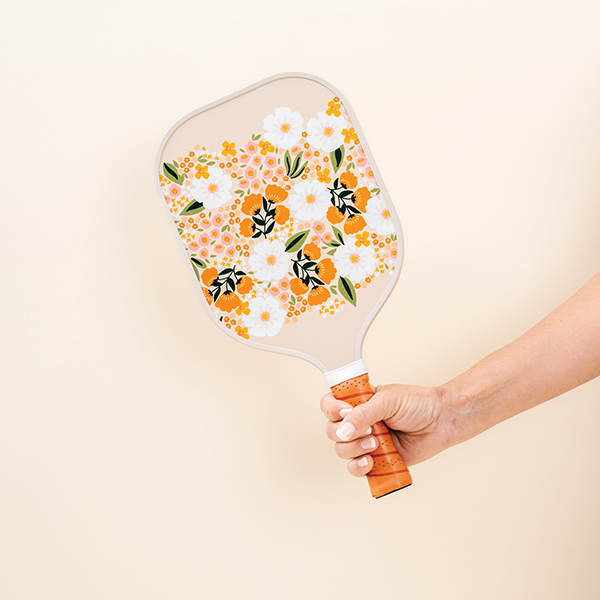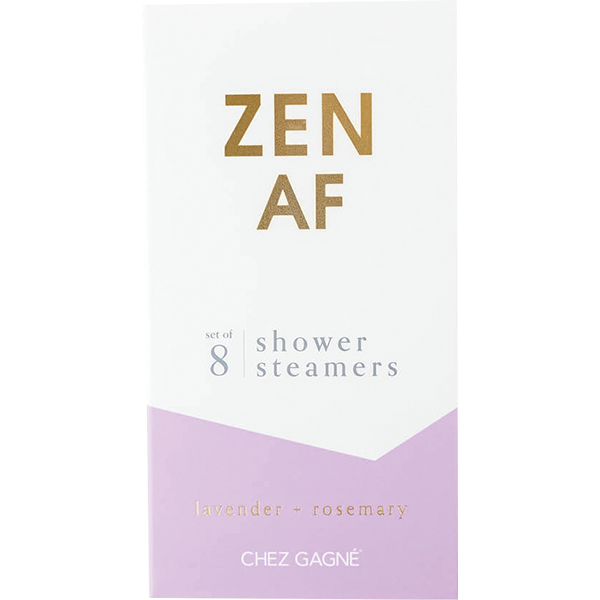Wearable Art
Trendy New Jewelry
Handmade art jewelry has become a hot fashion accessory in recent years—a must-have complement to a classy business outfit and a great way to grab attention at an evening party. According to Wendy Rosen —founder of The Buyers Market of American Craft, the trade show held every February and July at the Pennsylvania Convention Center in Philadelphia—jewelry buyers today are shifting focus from traditional gold and silver designs to more elaborate and artistic pieces made from materials not traditionally associated with jewelry.
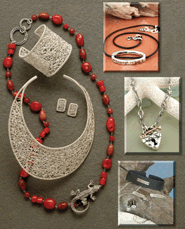 Rosen explains that while the modern jewelry market offers gold and silver options that are mass produced in developing countries and sold practically everywhere, from discount stores to shopping networks, not many of these pieces have been made with an eye to artistic design. Until recently, this devalued the importance of design, as people have bought jewelry “just to have a piece of gold,” she says. However, as consumers are becoming more aware of what they buy, they are beginning to respect things made by people with art backgrounds who are educated in design, according to Rosen.
Rosen explains that while the modern jewelry market offers gold and silver options that are mass produced in developing countries and sold practically everywhere, from discount stores to shopping networks, not many of these pieces have been made with an eye to artistic design. Until recently, this devalued the importance of design, as people have bought jewelry “just to have a piece of gold,” she says. However, as consumers are becoming more aware of what they buy, they are beginning to respect things made by people with art backgrounds who are educated in design, according to Rosen.
In recent months, the price of gold has been high, so even a “piece of gold” is getting increasingly difficult to afford. According to Rosen, however, people are not buying comparatively less expensive art jewelry merely because of the high price of precious metals. Instead, according to her, it’s all about fashion and changed consumer attitudes. “The value of jewelry is no longer weighed by the ounce, but by design,” Rosen says.
Retailers who offer art jewelry are tapping into a very desirable, affluent market. “These are people who recognize quality and uniqueness,” she says. “It’s a college-educated consumer, often with graduate school background, someone who doesn’t buy volumes of stuff, but pays attention to quality.”
According to the Jewelry Report 2005 Update by Unity Marketing, a Stevens, PA-based consumer research firm, the typical jewelry shopper spent $2,000 buying jewelry that year. (This average includes all jewelry—traditional as well as handmade art jewelry.) While fewer than half of those with incomes below $50,000 bought jewelry, nearly 60 percent of those earning $50,000 and above did so.
“Jewelry, being the ultimate luxury product, is far more widely purchased among the higher-income consumers than those of less financial status,” says the report. Among those who shop for jewelry, women, the target market for jewelry retailers, buy five pieces of jewelry (of all kinds, including art jewelry) a year on average. While most of them purchase only one piece at a time, about one-third of shoppers bought two to three jewelry pieces the last time they shopped.
Distinctive designs
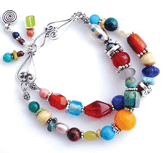 According to Rozanne Patten, who sells handmade jewelry at her boutique, Rozanne’s in Latham, NY, it is important for women to buy designs that are unique.
According to Rozanne Patten, who sells handmade jewelry at her boutique, Rozanne’s in Latham, NY, it is important for women to buy designs that are unique.
“Women always look for a piece they’re not going to see anywhere else,” she says. Jennifer McLamb, jewelry designer and owner of Beaded Bliss, agrees. “They don’t want to see someone else wearing the same necklace to a work meeting or social event,” McLamb says.
When Unity Marketing asked focus-group participants to name the things they look for when buying jewelry, distinctive designs and high quality were among the primary consider-ations. According to Rosen, professional women are an excellent target market for retailers of handmade jewelry.
Well-designed, elaborate pieces really stand out when paired with a sleek business suit or a plain collared shirt. “Business outfits are a perfect background for art jewelry,” says Rosen, who adds that professional women prefer handmade jewelry for the office because it looks chic and original, but not so valuable that “someone’s going to rip it off their neck in the street.”
“It’s about making a fashion statement, not a wealth statement,” she says.
Mary DeMarco has been creating handmade jewelry in Baltimore for nearly 20 years. Together with her husband, William “Buddy” Wolfe, she founded La Contessa and sells her jewelry to gift shops all over the United States.
Her whimsical designs evoke images of a beautiful garden. Inspired by nature, the bracelets, necklaces, pendants and earrings feature sunflowers, bees, dragonflies, turtles, and even frogs.
“My designs have a very light, summery feel, so they sell great at seaside locations, both at galleries and smaller gift shops,” DeMarco says.
 La Contessa’s necklace or bracelet clasps feature two hands joining together—DeMarco’s trademark. A tiny brass tag attached to the clasp is engraved with the artist’s name. In creating her collection, DeMarco uses pewter, jeweler’s brass and colorful semiprecious stones in different shapes and rich colors, as well as Austrian crystals and freshwater pearls. She says her jewelry shoppers try to avoid imported, low-quality pieces. “Many of my customers appreciate the fact that everything is handcrafted in the USA,” DeMarco says.
La Contessa’s necklace or bracelet clasps feature two hands joining together—DeMarco’s trademark. A tiny brass tag attached to the clasp is engraved with the artist’s name. In creating her collection, DeMarco uses pewter, jeweler’s brass and colorful semiprecious stones in different shapes and rich colors, as well as Austrian crystals and freshwater pearls. She says her jewelry shoppers try to avoid imported, low-quality pieces. “Many of my customers appreciate the fact that everything is handcrafted in the USA,” DeMarco says.
However, imported jewelry, such as the sterling silver pieces in Ruth Tamaroff’s Tamohara Collection, can also be very popular with American shoppers. Tamaroff was inspired to buy jewelry from artisans in other countries after years of traveling abroad. She started her business importing pieces from India, Guatemala, Mexico and Nepal, where she also guided women entrepreneurs on what Western women are likely to buy.
She carefully selects the most interesting pieces and brings home only those with exceptional design, high-quality workmanship and reasonable prices. Because of her extensive experience working abroad, Tamaroff has established personal relationships with the artisans. She demands top-quality craftsmanship and says the artisans receive a fair payment for their work. As part of Tamaroff’s collection, a carefully woven, silver cuff bracelet can be paired with a moon-shaped necklace collar. Another necklace is made from dozens of hammered sterling silver circles in different sizes, joined together in a chain and cascading down the neckline.
Tamaroff says most American women own numerous pieces of jewelry for different occasions. “Even though they’ll shop for traditional jewelry at department stores and large retailers, women still want to have a few unusual pieces in their collection.
“Women take a lot of care in how they pick their necklace or earrings,” she adds. “They want to have something a little different, not something that everyone else is wearing.”
According to Tamaroff, jewelry pieces—especially unique, handmade ones—are not just accessories, but also statements that can tell a lot about the person who wears them. Many pieces in the Tamohara Collection are large and elaborate. “It takes a little bit of confidence to wear something so big,” Tamaroff says. “An outstanding jewelry piece will immediately draw attention to the person who wears it.”
Unusual designs are also the specialty of importers Sue Edmonds and Jean Ringwalt, owners of the Melange Collection, based in Aspen, CO. The company sells gifts and jewelry pieces made by artisans in developing countries such as Guatemala, Peru, Armenia, Madagascar, Haiti, South Africa and Mali. Edmonds and Ringwalt work with community-based organizations in these countries to ensure the products they sell are created in safe work environments, that artisans earn fair wages, and that cultural traditions are respected. Creativity is encouraged and the materials used to make accessories are often surprising.
There are bracelets in the Melange Collection made with colorful glass beads and safety pins. Edmonds says handmade jewelry is very popular, because it often becomes a conversation piece.
“Wow, is it really made of safety pins?” is the most common response when people see her wearing the South African bracelet. “People really like it when others notice what they’re wearing,” she says.
Not just silver and gold
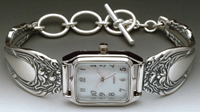 Art jewelry often attracts attention because it’s made of materials that people don’t normally associate with jewelry—not the usual combination of gold, silver or brass with colorful stones. Debra Dresler, the designer at Stroke of Art, creates jewelry from unusual materials like trinkets she finds at flea markets and antique stores. She likes to use whimsical materials and everyday objects, such as an old tape measure, bingo pieces or buttons. The Stroke of Art collection includes popular watches with bands made from old typewriter keys. “I wanted to do something different and do it better than anyone else,” Dresler says. “I’ve always been interested in things that had a little patina and history, things that look like they had a life before.”
Art jewelry often attracts attention because it’s made of materials that people don’t normally associate with jewelry—not the usual combination of gold, silver or brass with colorful stones. Debra Dresler, the designer at Stroke of Art, creates jewelry from unusual materials like trinkets she finds at flea markets and antique stores. She likes to use whimsical materials and everyday objects, such as an old tape measure, bingo pieces or buttons. The Stroke of Art collection includes popular watches with bands made from old typewriter keys. “I wanted to do something different and do it better than anyone else,” Dresler says. “I’ve always been interested in things that had a little patina and history, things that look like they had a life before.”
Dresler started her art career in fabric surface design, calligraphy, photography and painting. When she later came to jewelry, she decided that the market for gold and silver products was full and that she had nothing to add in this realm. She created her first “typewriter watch” 15 years ago. Even though many people were skeptical about her idea, the watch became a great success.
“I got a tremendous reaction from everyone, from 20 to 70 years old,” she says. Dresler says she likes to break out of normal expectations, and that an increasing number of jewelry shoppers appreciate that approach. “People are so tired of mass-produced pieces, and this is real work made by a human being,” she says. “You can always get a watch that was made by a machine. There is something special about handcrafted watches. They read more into our senses, and just happen to tell time.”
Kathleen Plate, of Smart Glass Jewelry in Atlanta, uses high-quality glass to create her collection of earrings, bracelets and necklaces. “It’s the same traditional method used in stained-glass windows and lampshades, but I create much cleaner and modern designs,” she says.
Plate’s first jewelry creation was a pair of glass earrings she made for a friend’s birthday present. Everyone at the party saw the earrings and wanted a similar pair, and it became a start to a successful business. Plate calls her designs a very “wearable” line. “The glass I use is rounded, very dynamic—it moves with the body movements and light shines through the glass when you turn your head,” she says.
Plate says it’s natural for people to appreciate things that are handmade. “It’s almost magical to own something that came from the hands of another person,” she says. “There’s something magical in the process of creating jewelry.”
McLamb, from Beaded Bliss, uses offbeat materials, such as dichroic glass and clay embedded with precious metals, to create her jewelry pieces.
Dichroic glass is glass in two colors. It was developed by the aerospace industry and is created using a complicated process in which the glass is coated with thin layers of metal oxides in a high-temperature vacuum chamber. In her designs, McLamb cuts and combines the dichroic glass in myriad color combinations using very high temperatures (up to 1,500 degrees Celsius) to fuse colors. The other high-tech material McLamb uses is precious metal clay—a pliable, clay-like combination of precious metals (gold, silver or platinum) mixed in with an organic binder. Without using high heat (as is necessary with pure gold or silver), the flexible clay can be easily molded and then kiln-fired to burn away everything but the precious metal. The end result is a one-of-a-kind piece of jewelry. McLamb often combines different materials in her designs. She recently began to use fine silver pieces as framework for beading.
About the artist
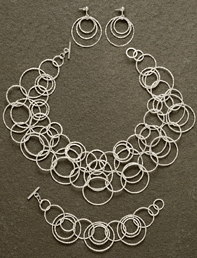 According to McLamb, when consumers are buying a piece created by an individual artist, they want to learn a little bit about that person, what inspired the design, and why the artist chose certain materials over others.
According to McLamb, when consumers are buying a piece created by an individual artist, they want to learn a little bit about that person, what inspired the design, and why the artist chose certain materials over others.
“The reason people purchase handmade jewelry over mass-produced pieces is because there’s a story and human touch, a quality and spirituality in every single piece. Handmade jewelry has more meaning as a gift—people feel like it’s a value added to their purchase,” McLamb says.
Every piece of Beaded Bliss jewelry comes with information about the artist and a description of technique and material used in creating the piece.
Tamaroff says that to successfully sell handmade jewelry, retailers should know as much as possible about the artist or the designer. “It makes things really exciting and adds a personal touch,” she says.
When Tamaroff sells to gift-shop owners, she always gives them a little background about the person who created the pieces in the collection. “Customers appreciate the extra touch, the fact that there’s a ‘story’ behind every piece. It adds a personal touch and makes the shopping experience more special,” she says.
Tamaroff suggests that it might be a good idea to display photos of the artisans. “People like to have a personal story behind every piece of jewelry, a connection of some kind,” she says. “They appreciate the culture it came from.”
DeMarco offers gift boxes personalized with her name and company logo. She also distributes cream-colored cards with information about herself, the inspiration for her jewelry and the materials she uses in her designs—perfect to slip into the gift box.
At Mark August, a seaside gift shop in Chatham, MA, members of the sales staff volunteer information about the artist, even if customers don’t ask. “We have little bios of artists in glass cases together with their jewelry pieces, so people can read about them,” says Liz Schenke, the shop’s co-owner.
Think out of the box
Retailers and artists agree that the way art jewelry is presented can have a huge impact on sales. Mark August, located in a town frequented by tourists, sits on a main street that is perfect for strolling and window-shopping. It sells Kathleen Plate’s glass jewelry, among other designs. Schenke says many jewelry purchases are unplanned; people come into the store to browse and find something they love. To showcase Plate’s designs, Schenke and her business partner, Corinne Blakeney, present the pieces on dark suede trays—a perfect background to bring out the features of the glass and to emphasize its vibrant colors.
The ceiling fans in the store have glass pulls created by Plate. “They reflect light and immediately attract attention. People ask questions and find out about the jewelry,” Schenke says.
Customers are welcome to touch the jewelry and try it on. “You sell much more if people can touch the jewelry,” Schenke says. Members of the sales staff also wear different jewelry pieces—enough to attract customers’ attention, without overdoing it.
DeMarco says retailers do best when they offer a wide selection of jewelry by a single artist. “Carry at least a couple dozen pieces, enough to make a statement, tell a story,” she advises. “The more you have, the more you sell.”
Since La Contessa jewelry comes in color themes from blues and greens to warmer, coral tones, it’s good to organize by color group and showcase the work by using neck forms and earring trays. Patten, who sells pieces from the Tamohara collection, uses glass cases with glass shelves and lighting that shows off each piece and brings out detail, an important factor in handmade jewelry. “We use neck stands and velvet pillows, a little china shoe, and mirrors, things that draw the eye to the jewelry piece,” she says.
Patten says her customers often ask for advice and want to be told what piece of jewelry will match a particular outfit. “You have to pay careful attention to the customer’s style,” she says. “Don’t offer something elaborate to an elegant woman wearing classic clothes. She will appreciate a quieter style.”
Patten says some women come in looking for jewelry by a particular artist, but most will choose by style and many need advice, so the sales staff should be trained in helping customers choose appropriate pieces.
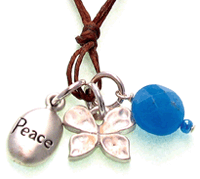 Edmonds and Ringwalt use the attention-grabbing quality of handmade jewelry to boost sales. According to Edmonds, “wear the stuff you sell” is the best strategy in the jewelry retail business. Complete strangers often approach Edmonds saying they really love her jewelry, and asking where they might buy a similar piece, she says. She advises gift-shop owners to always wear the pieces they sell—when they go out shopping, to dinner or to any social event.
Edmonds and Ringwalt use the attention-grabbing quality of handmade jewelry to boost sales. According to Edmonds, “wear the stuff you sell” is the best strategy in the jewelry retail business. Complete strangers often approach Edmonds saying they really love her jewelry, and asking where they might buy a similar piece, she says. She advises gift-shop owners to always wear the pieces they sell—when they go out shopping, to dinner or to any social event.
“It’s a great way to drive traffic to the store,” she says. Allison Ernst is general manager of family-owned River’s Edge Gallery, based in the Cincinnati Airport, which sells gifts, accessories and jewelry handcrafted by artists from the local area. She says many of her customers need advice, and that it’s important to get to know them, what they like, and their reason for buying a piece of jewelry. Then it’s easier to offer suggestions and help the customer find something they’ll like.
If a man is shopping for jewelry for his wife, the saleswoman will give advice and offer to try it on herself, so the customer can see what the piece will look like out of the box. The airport location works great for the gallery, with thousands of people passing by every day. “We have a very captive audience, because people often buy jewelry as a memento, to remind them of the trips they had,” says Ernst. “Instead of a box of chocolates, they’ll buy a Kentucky-made piece of jewelry.”
Lucky charms
Marcia Maizel-Clarke, creative director and founder of Dogeared Jewels and Gifts, in Venice, CA, founded Dogeared on the assumption that even today, jewelry pieces are used not merely as accessories, but also as charms or talismans that can bring luck or make wishes come true. She says her company’s “Make-A-Wish” necklaces have been doing exceptionally well. The necklaces come with special note cards instructing the wearer to: “Make your wish and put on this necklace. When your necklace wears off your wish is ready to come true.”
As part of the necklace, tiny gold- or silver-dipped charms in different shapes come on silk threads, which disintegrate over time. Maizel-Clarke says the necklaces empower people; they give hope and help people believe in themselves and their dreams.
“We send out positive energy into the world; it’s an amazing concept,” she says. “What I think works for us is that the world is a little funky right now; there are a lot of negative things going on. What we’re trying to do is send positive energy into the world. If you get a charm and make a wish, you might try harder for it to come true, whether it’s losing weight, becoming a better person, forgiving someone, or anything else. I know it sounds a little hokey, but it’s true, and it really works.”
Other Dogeared necklaces—the more permanent kinds on gold or silver chains—celebrate success, joy, friendship, love and happiness. There are necklaces for sisters, friends, hope, peace, strength and power.
A creative display, the right sales approach and a variety of truly unique pieces are important factors in jewelry sales. But the nice thing about art jewelry is that it’s so eye-catching, it practically sells itself. As Ernst advises: “Just get them to try it on.”



















